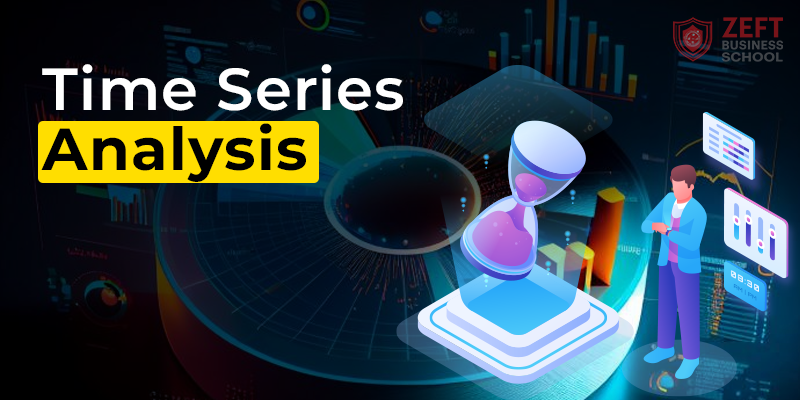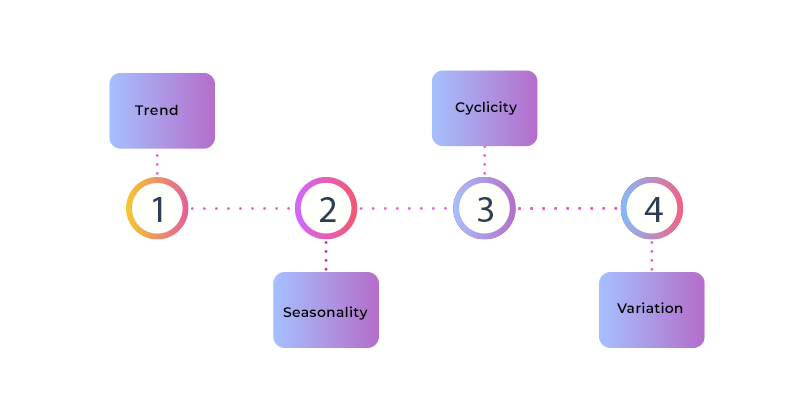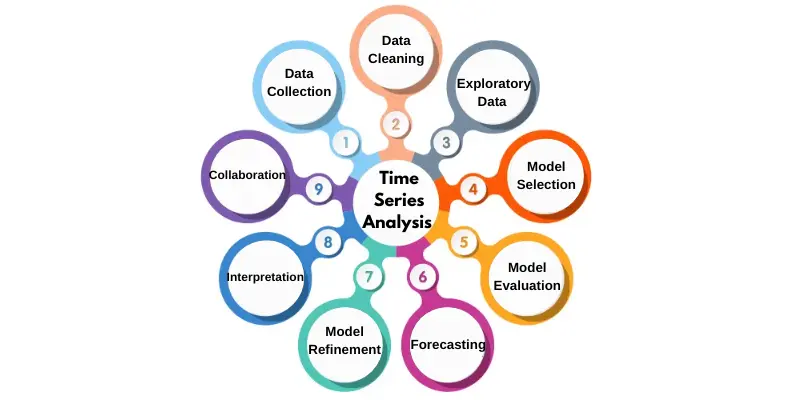Ever imagined a world where you could predict the future of your business with remarkable accuracy? What if you knew exactly how much inventory to stock, how your sales would fluctuate throughout the year, or how the market might react to your latest product launch? This isn’t science fiction; it’s the magic of time series analysis and forecasting. This powerful technique empowers business analysts to leverage historical data and make data-driven decisions that propel businesses towards significant growth.
What is Time Series Analysis?
Time series data is a captivating narrative told over time. It’s a collection of data points captured at consistent intervals, like daily customer visits to your website, monthly sales figures, or hourly stock prices on the exchange. Each data point represents a snapshot in time, allowing you to track changes, identify patterns, and uncover the underlying rhythm of your business.
Time series analysis is the art of dissecting this data to understand its structure, trends, and seasonality. This analysis lays the foundation for time series forecasting, where we leverage sophisticated statistical models to predict future values in the series.
Components of Time Series
Imagine a time series as a wave on the ocean. It has several distinct characteristics:
- Trend: This is the long-term underlying direction of the series. Is it generally increasing, decreasing, or staying flat over time? Identifying the trend helps us understand the overall trajectory of the data.
- Seasonality: This refers to predictable fluctuations within a specific period of time, like monthly sales spikes during holidays or daily website traffic surges during peak hours. Seasonality can be identified by analysing cyclical patterns in the data.
- Cyclicity: Cyclical patterns in time series analysis are broader fluctuations that occur over extended periods, like economic booms and busts. These cycles can be more challenging to identify and predict but are crucial for long-term forecasting.
- Variation: This component represents the data’s random fluctuations or “noise” that the trend, seasonality, or cyclicity cannot explain.
By dissecting the time series data, we gain valuable insights into the past and present behavior of the variable we’re studying. This sets the stage for the next step,
Time Series Forecasting
Time series forecastingleverages the insights from time series analysis to predict future values. It’s like using the knowledge of past trends and seasonality to make educated guesses about what might happen next.
This forecasting is achieved through sophisticated statistical models like ARIMA or SARIMA. Imagine using historical data to make informed predictions about your business’s future. Time series forecasting, a cornerstone of an MBA in Business Analysis, allows you to do just that. This “educated guesswork” is achieved through sophisticated statistical models, each with its own strengths and weaknesses.
Statistical Methods for Time Series Forecasting
There’s no one-size-fits-all approach to time series forecasting. The best strategy for your data is determined by its individual properties. Here are some popular statistical methods that business analysts utilise:
Autoregressive Integrated Moving Average (ARIMA)
This powerful model is ideal for forecasting stationary data (data with constant mean and variance over time). It considers past values of the series (Autoregressive—AR) and past forecast errors (Moving Average—MA) to predict future values. The “Integrated” (I) part refers to necessary data transformations to achieve stationarity.
Seasonal ARIMA (SARIMA)
When data exhibits seasonality (predictable fluctuations over time, like monthly sales spikes during holidays), ARIMA is extended to SARIMA. This model incorporates seasonal components into the forecasting process, leading to more accurate predictions for data with seasonal trends.
Exponential Smoothing
This is a more straightforward approach for time series forecasting that assigns weights to past data points, with more weight given to recent observations. It’s particularly effective for short-term forecasting of time series data with low variability, like daily website traffic.
Beyond the Classics
Depending on the complexity of your time series data, other techniques, such as neural networks or machine learning algorithms, might be employed for even more sophisticated forecasting. If you want to hone your analytical expertise, Look for MBA Coaching Near Me. Many reputable institutions offer programs designed to equip you with the skills and knowledge to be a pro in this field.
Building Blocks of Forecasting Models
Time series forecasting models leverage these components of time series data to predict future values. Here are some essential elements:
- Historical Data: The foundation of any forecasting model is historical data. The more data you have, the better the model can learn the underlying patterns and trends in the series.
- Model Selection: As discussed earlier, there are various forecasting models, each with its strengths and weaknesses. Choosing the suitable model based on the characteristics of your data, like stationarity and seasonality.
- Model Parameters: Each forecasting model has specific parameters that need to be estimated from the historical data. These parameters determine how the model weights past values and seasonality to make predictions.
- Error Correction: No time series forecasting model is perfect, and errors will always be between predicted and actual values. Error correction techniques are used to refine the model and improve its forecasting accuracy over time.
Factors to Choose The Best Forecasting Method
The key to unlocking the full potential of time series forecasting lies in selecting the most suitable method for your data. Here are some key factors to consider:
Stationarity: As mentioned earlier, ARIMA and SARIMA require stationary data. If your data exhibits trends or seasonality, transformations might be necessary.
Data Availability: The chosen method should be compatible with the historical data available. For optimal performance, more complex models often require larger datasets.
Accuracy Requirements: The level of accuracy needed will influence the complexity of the model. For instance, short-term sales forecasts might require a different level of detail than long-term financial projections.
By understanding these building blocks and selection factors, you’ll be well on your way to leveraging time series forecasting for better business decision-making. Consider exploring the curriculum of Top MBA Colleges in Chennai to see how their Business Analytics programs can equip you with these valuable skills.
Step-by-Step Guide for Time Series Analysis Forecasting
Time series forecasting isn’t magic; it’s a well-defined process. Here’s a roadmap to guide you through:
Data Collection
Gather relevant historical data for the variable you want to forecast. This could be internal data from your CRM system or external data from market research reports.
Data Cleaning and Preprocessing
Address missing values, outliers, and inconsistencies to ensure the quality of your data. “Garbage in, garbage out” also applies to forecasting; clean data leads to more reliable predictions.
Exploratory Data Analysis
Analyse the data to understand its characteristics, trends, and seasonality. This initial exploration will guide your forecasting method and help you identify potential challenges.
Model Selection and Training
Choose a suitable forecasting model based on your time series data and the level of accuracy required. Train the model on your historical data, allowing it to learn the underlying patterns.
Model Evaluation
Evaluate the model’s performance using metrics like Mean Squared Error (MSE) or Mean Absolute Error (MAE). A lower error value indicates a better fit between the model and the data.
Forecasting
Once you’re confident in the model’s accuracy, use it to predict future values in the time series. This is the exciting part; you’ll be peering into the future with data-driven insights!
Model Refinement and Monitoring
No forecast is perfect. After generating predictions, assessing and refining the model’s accuracy is crucial. Here’s how:
- Compare forecasts with actual values: Analyse the difference between predicted and actual values to identify systematic biases or errors.
- Evaluate forecast errors: Metrics like Mean Absolute Percentage Error (MAPE) help quantify the model’s accuracy. A lower MAPE indicates a better fit.
- Fine-tune the model: Based on the evaluation, adjust model parameters or explore alternative methods to improve forecasting accuracy.
The Art of Interpretation
Time series forecasting is more than just generating numbers. The real power lies in interpreting and translating the results into actionable insights. Consider these aspects:
- Understand the limitations: Forecasts are estimates, not guarantees. Factors beyond the model’s scope can influence future outcomes.
- Identify turning points: Look for significant deviations in the forecast, which could signal potential changes in the underlying trends.
- Communicate effectively: Present your findings clearly and concisely, highlighting key insights and potential risks.
The Power of Collaboration
Time series analysis and forecasting are not solitary endeavours. Collaboration between business analysts, data scientists, and domain experts is crucial for success. Each brings a unique perspective, leading to:
- Data-driven decision-making: Analysts translate forecasts into actionable insights that inform business strategies.
- Domain expertise integration: Domain experts provide context and understand the factors influencing the data, leading to more accurate forecasts.
- Continuous improvement: Collaboration fosters a culture of learning and improvement, leading to better forecasting models over time.
Considering a Career in Business Analytics? MBA Courses in Chennai can equip you with the necessary skills and knowledge to excel in this dynamic field. An MBA program focusing on business analytics provides a strong foundation in time series in statistics, data mining, and modelling techniques. You can understand time series analysis more deeply by exploring advanced forecasting models like ARIMA, SARIMA, and Prophet.
Why Time Series Analysis is Important?
The importance of time series is in its ability to transform historical data into actionable insights. Businesses across industries rely on it for a competitive edge:
Demand Forecasting
Imagine predicting future sales with remarkable accuracy. This would allow businesses to optimise inventory management, resource allocation, and production planning, ensuring they have the right products in stock at the right time, minimising costs, and maximising customer satisfaction.
Financial Planning with Confidence
Businesses can use time series forecasting to estimate future revenue, expenses, and cash flow. This foresight allows for sound financial planning, ensuring adequate funds for investments and day-to-day operations.
Market Analysis
Analysing historical market trends can give businesses valuable insights into consumer behaviour and market fluctuations. This knowledge empowers businesses to make informed investment decisions, tailor their marketing campaigns, and stay ahead of the curve.
Risk Management- Proactive Protection
Identifying potential fluctuations in customer behaviour or market trends allows businesses to mitigate risks and prepare for unforeseen circumstances. Proactive measures, like adjusting marketing campaigns or diversifying product offerings, can significantly minimise potential losses.
The Future of Time Series Analysis
The field of time series analysis is constantly evolving. Here are some exciting trends to watch:
- Advanced Machine Learning
Integrating machine learning algorithms with traditional statistical methods leads to more powerful and adaptable forecasting models. These models can handle complex data patterns and generate even more accurate predictions.
- Big Data Analytics
The ability to handle extensive data sets, also known as big data, allows for more comprehensive analysis and accurate predictions. With larger datasets, forecasting models can capture even subtler nuances in the data, leading to more robust forecasts.
- Real-time Forecasting
Advanced techniques enable businesses to make forecasts based on real-time data streams, allowing for faster and more responsive decisions.
Time series analysis and forecasting equip businesses with the power to predict future trends and make informed decisions. By understanding time series data, utilising appropriate statistical methods, and fostering a culture of collaboration, businesses can utilise the full potential of this powerful technique and navigate the ever-changing future with confidence.
Ready to embark on your time series forecasting journey? A vast number of resources are available online and in libraries to help you get started. For those seeking a structured learning path, consider pursuing an MBA in Business Analytics in Chennai. These programs delve deep into time series analysis and other valuable business analytics techniques, preparing you to make data-driven decisions and propel businesses forward. Check out our blog on the evolving role of business intelligence in future. With dedication and practice, you’ll be well on your way to harnessing the power of time series analysis for business success.




